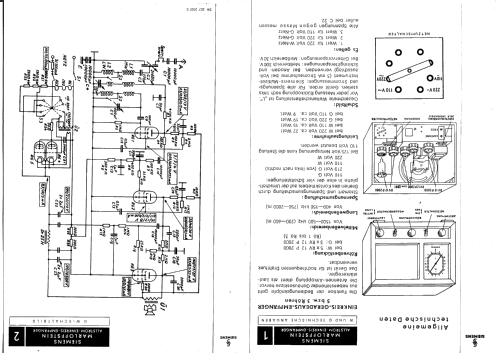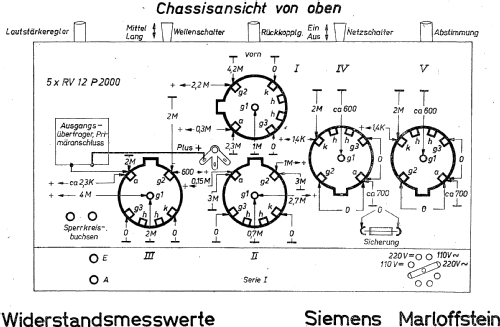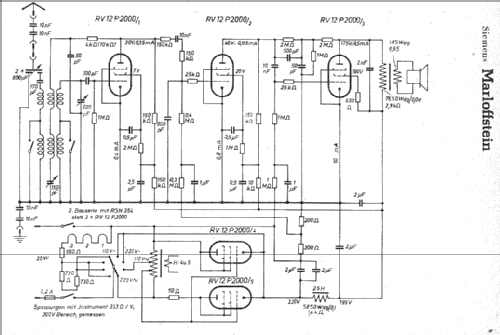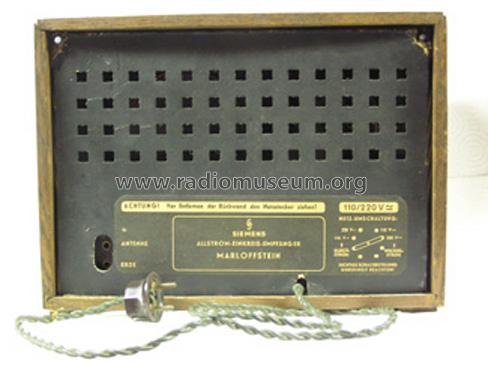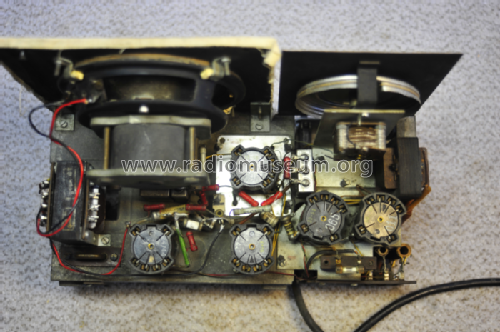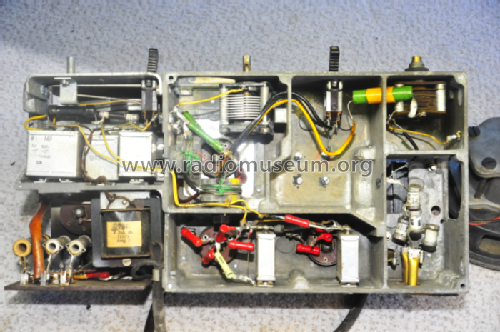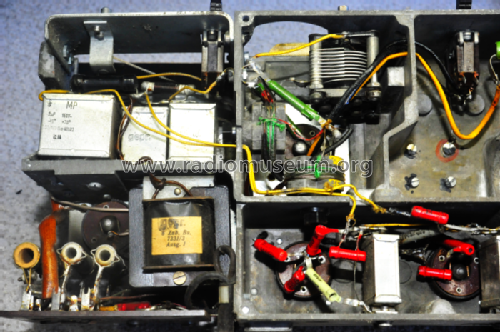Marloffstein 1 (I)
Siemens (& Halske, -Schuckert Werke SSW, Electrogeräte); Berlin, München
- Paese
- Germania
- Produttore / Marca
- Siemens (& Halske, -Schuckert Werke SSW, Electrogeräte); Berlin, München
- Anno
- 1946/1947
- Categoria
- Radio (o sintonizzatore del dopoguerra WW2)
- Radiomuseum.org ID
- 5297
Clicca sulla miniatura dello schema per richiederlo come documento gratuito.
- Numero di tubi
- 5
- Principio generale
- A reazione (con rigenerazione); 2 Stadi BF
- N. di circuiti accordati
- 1 Circuiti Mod. Amp. (AM)
- Gamme d'onda
- Onde medie (OM) e onde lunghe (OL).
- Tensioni di funzionamento
- Alimentazione universale (doppia: CC/CA) / DC: 110; 220 or AC: 110; 220 Volt
- Altoparlante
- AP magnetodinamico (magnete permanente e bobina mobile)
- Materiali
- Mobile in legno
- Radiomuseum.org
- Modello: Marloffstein 1 - Siemens & Halske, -Schuckert
- Forma
- Soprammobile compatto/con bordi arrotondati/midget senza pulsantiera/tastiera.<= 35 cm (Sometimes with handle but for mains only).
- Dimensioni (LxAxP)
- 305 x 225 x 167 mm / 12 x 8.9 x 6.6 inch
- Annotazioni
-
Der Siemens-Empfänger Marloffstein verwendet für Betrieb am Wechselstromnetz 110/220V einen Autotrafo mit separater Heizwicklung für 2x RV12P2000, die als Gleichrichter parallel geschaltet sind.
In Stellung Gleichstrom 110/220V sind diese Röhren Rö. 4 und 5 nicht in Funktion, die Netzspannung ist direkt zur Siebkette durchgeschaltet.
Lediglich das originale Hersteller-Schema zeigt die Spannungswerte für 3 Netzspannungen 220VAC, 220VDC und 110VDC.
Siehe auch technisch identisches Modell Marloffstein aus Fertigung Fernmeldewerk Arnstadt.
- Peso netto
- 4.1 kg / 9 lb 0.5 oz (9.031 lb)
- Fonte dei dati
- Radiokatalog Band 1, Ernst Erb
- Riferimenti schemi
- Lange + Schenk Heft 29 von 1947
- Bibliografia
- Funkgeschichte der GFGF (9388)
- Letteratura / Schemi (1)
- -- Original-techn. papers.
- Altri modelli
-
In questo link sono elencati 2522 modelli, di cui 2119 con immagini e 1334 con schemi.
Elenco delle radio e altri apparecchi della Siemens (& Halske, -Schuckert Werke SSW, Electrogeräte); Berlin, München
Collezioni
Il modello Marloffstein fa parte delle collezioni dei seguenti membri.
Discussioni nel forum su questo modello: Siemens & Halske, -: Marloffstein 1
Argomenti: 2 | Articoli: 14
The description and operation is described on page 4 of the Original brochure, and I include the German language text, and the translations from Babelfish and my edits (which are probably in error - as I have been told).
I have also detected a 1M ohm resistor leading into the plate circuit of the audio output tube. . . .the schematic depicts a 2M ohm, then another 2M ohm resistor leading into the tube.
Translations are as follow:
ORIGINAL
Dabei gilt die obere Hälfte der Skala (M). Beim Empfang nahe liegender starker Sender (Ortssender) wird der Drehknopf für die Rückkopplung (der mittlere) bis zum Anschlag nach links gedreht und die Lautstärke mit dem rechten Drehknopf geregelt. Hierauf wird mit dem Abstimmknopf die Einstellung nochmals verbessert.
Bei Farnempfang kann durch Drehen des Rückkopplungsknopfes nach rechts eine zusätzliche Erhöhung der Lautstärke und der Trennschärfe erreicht werden. Durch Betätigen des Lautstärkeknopfes wird der Empfang dann wieder aus normale Lautstärke eingeregelt und am Abstimmknopf die Einstellung verbessert. Die Rückkopplung darf nur bis kurz vor dem Einsetzen des Pfeiftones (Schwingungseinsatz)nach rechts gedreht werden.
BABELFISH
The following procedures apply to the upper half of the scale (M). With the receipt close lying strong transmitter (short-distance transmitters) is turned to the left the rotary button for the feedback (the middle) up to the notice and the volume with the right rotary button is regulated. With the co-ordination button the attitude is again improved on that.
With fern receipt through tricks of the feedback button an additional increase of the volume and the discrimination can be achieved to the right. The receipt is then in-regulated again from normal volume and improved pressing of the volume button at the co-ordination button the attitude. The feedback may only to short before using the whistler (Schwingungseinsatz)nach to be right turned.
SARBELL TRANSLATION
The following procedures apply for the upper half of the radio dial scale (M). With the reception of nearby strong transmitters (local stations), the rotary knob for the feedback (the middle) is turned to the left up to the stop, and the volume is regulated with the right rotary knob. With very slight adjustment of the feedback knob, the overall reception can be improved again slightly.
With weak reception, additional increase of the volume and station discrimination can be achieved through manual adjustments of the feedback knob slightly more to the right. The reception is then again fed back from the normal volume, and improved by rotating the volume knob while slight adjustment is made to the tuning and feedback knobs. The feedback knob may only be turned a short distance to the right (clockwise) before the "whistling sound" begins to occur as the knob is turned further to the right.
Respectfully,
robert Sarbell
Robert Sarbell † 22.3.22, 21.Sep.05
Also, the schematic does not depict a lamp for the illumination of the dial - I presume there was no requirement to illuminate the dial in a dimly lit room.
Respectfully,
RoSa
Robert Sarbell † 22.3.22, 31.Aug.05

